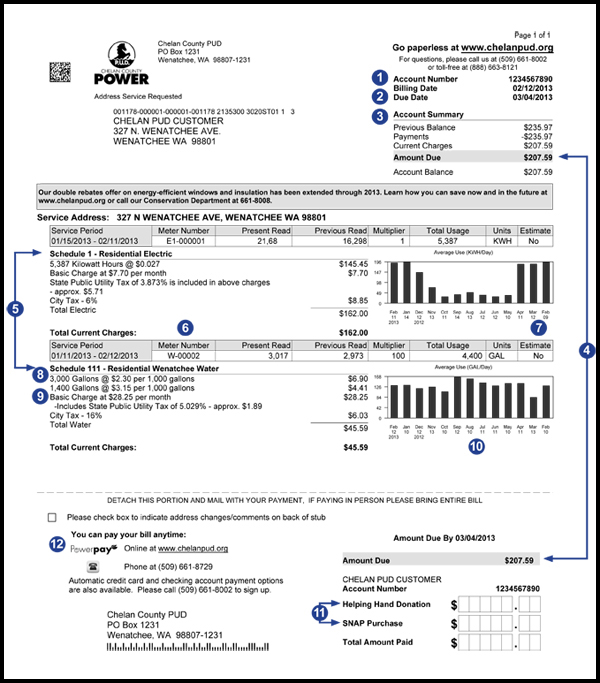To help understand your bill, scroll down to the numbers below
this sample. Each number corresponds to a specific item on
the bill. Questions? Call (509) 661-8002.

-
Account Number. Use this number when
calling us about your bill. Customers who use online
bill-paying services through a bank should provide this
number.
-
Due Date. Shows the date your bill is
due.
-
Account Summary. Shows the charges,
including total payments since last bill.
-
Amount Due. Shows the total amount due.
-
Consolidated Billing. If you have
multiple services from Chelan PUD, they are combined on a
single statement. This bill shows electric and water
service. Customers with several services may receive
bills with several pages.
-
Meter Information. Shows the meter
readings used to calculate your bill. For energy use,
it's kilowatt hours (kWh); water consumption is
measured in gallons. In some cases, the meter does not
have sufficient capacity to register the customer’s
consumption, and a multiplier must be used. Some meters
are designed to record only a fraction of the actual
kilowatt hours or gallons. These meter readings must be
multiplied by a specific factor – the multiplier
– to determine actual consumption. Meters with
sufficient capacity have a multiplier of 1. Most
residential electric meters have a multiplier of 1 or 10;
most water meters have a multiplier of 100.
-
Estimated Use. Meters are read monthly,
but sometimes meter readers cannot access meters. In
those cases, use is estimated and you will see a
“Yes” listed. “No” in this case
means the bill is based on an actual reading, not an
estimate.
-
Rate Schedule. The rate used to
calculate your bill. Most residential electric customers
are schedule 1 customers. Rate schedules are available on
the
rates page of this website, or you can
request them by calling (509) 661-8002.
-
Basic Charge. This charge is associated
with maintaining services, reading meters, billing
expenses and other general administrative costs.
-
Consumption Graph. Use this chart to
compare your energy and/or water use from month to month.
-
Helping Hand and SNAP contribution. If
you would like to contribute to Helping Hand (help
low-income families pay their utility bills) or SNAP
(purchase locally produced wind and solar power), write
the amount(s) in the box(es). Add these additional
amounts to the “Amount Due.” Write the new
total in the box next to “Total Amount Paid.”
Note: If you have signed up to contribute to Helping Hand
or SNAP on a monthly basis, this amount is automatically
added to your bill and is reflected in the printed total.
You do not need to add these contributions to the bill
total.
-
Payment Stub. Tear off and enclose
this with your payment. Note the automatic credit card
payment or checking account deduction. You can still
donate to Helping Hand or SNAP.